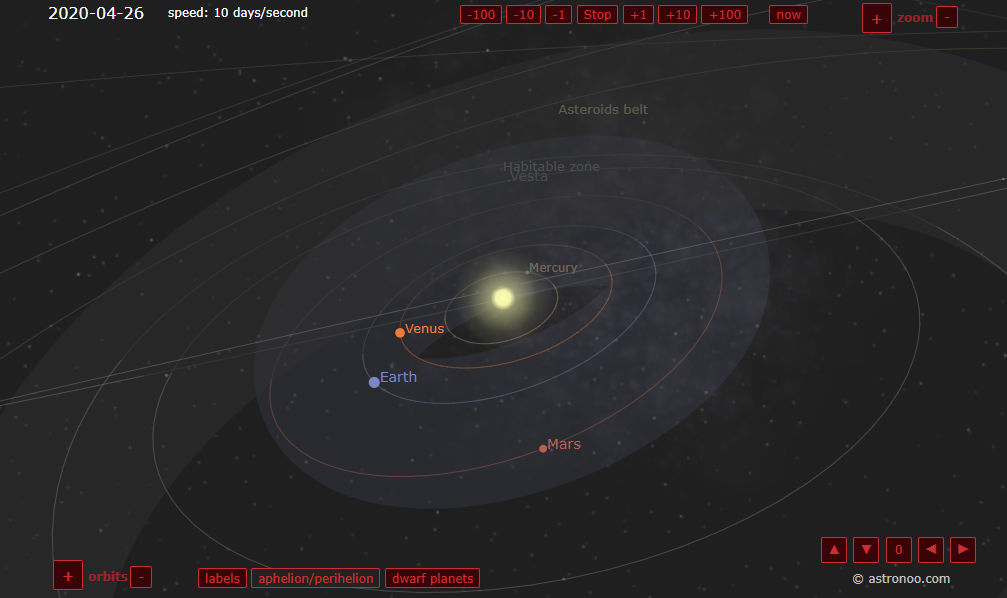用.NET模擬天體運動
阿新 • • 發佈:2019-12-16
用.NET模擬天體運動
這將是一篇罕見而偏極客的文章。
我上大學時就見過一些模擬太陽系等天體運動的軟體和網站,覺得非常酷炫,比如這個(http://www.astronoo.com/en/articles/positions-of-the-planets.html):

其酷炫之處不僅在於天體運動軌跡能畫出美妙的弧線,更重要的是其運動規律完全由萬有引力定律產生,不需要對其運動軌跡進行程式設計。所有天體受其它天體的合力,然後按照其加速度執行。只需一個起始座標和起始速度,就能坐下來欣賞畫面。
我從大學畢業後就一直對這個抱有深厚興趣,工作第一年時我就用C++做過一版;後來我負責公司前端工作,又用js/canvas
.NET“革命”,我近期又用C#/.NET再次重製了一版。
需要的數學知識
由於是程式看數學知識,此處我將使用程式碼來表示公式。
- 萬有引力,該力
F與兩個天體的質量m1,m2成正比,如距離r的平方成反比,用程式碼表示為:F = m1 * m2 * G / r ^ 2; - 牛頓第二定律,加速度
a等於合力F除以質量m,用程式碼表示為:a = F / m; - 速度
v與加速度a以及時間t的關係,用程式碼表示為:v = a * t; - 距離
s與速度v以及時間t的關係,用程式碼表示為:s = v * t。
這裡面的所有知識都已經在高中物理提過了,但有兩點需要注意:
- 所有的力、加速度、速度以及距離都需要分為
x軸和y軸兩個分量; - 所有的時間
t實際上是小段時間dt,程式將迴圈模擬小段時間累加起來,來模擬天體運動。
核心程式碼
天體類:
class Star { public LinkedList<Vector2> PositionTrack = new LinkedList<SharpDX.Vector2>(); public double Px, Py, Vx, Vy; public double Mass; public float Size => (float)Math.Log(Mass) * 2; public Color Color = Color.Black; public void Move(double step) { Px += Vx * step; Py += Vy * step; PositionTrack.AddFirst(new Vector2((float)Px, (float)Py)); if (PositionTrack.Count > 1000) { PositionTrack.RemoveLast(); } } }
注意,我沒指定大小Size,直接給值為其質量的對數乘2,另外注意我使用了一個PositionTrack的連結串列來儲存其運動軌跡。
萬有引力、加速度、速度計算
void Step()
{
foreach (var s1 in Stars)
{
// star velocity
// F = G * m1 * m2 / r^2
// F has a direction:
double Fdx = 0;
double Fdy = 0;
const double Gm1 = 100.0f; // G*s1.m
var ttm = StepDt * StepDt; // t*t/s1.m
foreach (var s2 in Stars)
{
if (s1 == s2) continue;
var rx = s2.Px - s1.Px;
var ry = s2.Py - s1.Py;
var rr = rx * rx + ry * ry;
var r = Math.Sqrt(rr);
var f = Gm1 * s2.Mass / rr;
var fdx = f * rx / r;
var fdy = f * ry / r;
Fdx += fdx;
Fdy += fdy;
}
// Ft = ma -> a = Ft/m
// v = at -> v = Ftt/m
var dvx = Fdx * ttm;
var dvy = Fdy * ttm;
s1.Vx += dvx;
s1.Vy += dvy;
}
foreach (var star in Stars)
{
star.Move(StepDt);
}
}注意其中有個foreach迴圈,它將一一計算每個天體對某天體的力,然後通過累加的方式求出合力,最後依照合力計算加速度和速度。如果使用gmp等高精度計算庫,該迴圈將存在效能熱點,因此可以將這個foreach改成Parallel.For加lock的方式修改合力Fdx和Fdy,可以提高效能(C++的程式碼就是這樣寫的)。
繪圖程式碼
public void Draw(DeviceContext ctx)
{
ctx.Clear(Color.DarkGray);
using var solidBrash = new SolidColorBrush(ctx, Color.White);
float allHeight = ctx.Size.Height;
float allWidth = ctx.Size.Width;
float scale = allHeight / 100.0f;
foreach (var star in Stars)
{
using var radialBrush = new RadialGradientBrush(ctx, new RadialGradientBrushProperties
{
Center = Vector2.Zero,
RadiusX = 1.0f,
RadiusY = 1.0f,
}, new SharpDX.Direct2D1.GradientStopCollection(ctx, new[]
{
new GradientStop{ Color = Color.White, Position = 0f},
new GradientStop{ Color = star.Color, Position = 1.0f},
}));
ctx.Transform =
Matrix3x2.Scaling(star.Size) *
Matrix3x2.Translation(((float)star.Px + 50) * scale + (allWidth - allHeight) / 2, ((float)star.Py + 50) * scale);
ctx.FillEllipse(new Ellipse(Vector2.Zero, 1, 1), radialBrush);
ctx.Transform =
Matrix3x2.Translation(allHeight / 2 + (allWidth - allHeight) / 2, allHeight / 2);
foreach (var line in star.PositionTrack.Zip(star.PositionTrack.Skip(1)))
{
ctx.DrawLine(line.First * scale, line.Second * scale, solidBrash, 1.0f);
}
}
ctx.Transform = Matrix3x2.Identity;
}注意我在繪圖程式碼邏輯中做了一些矩陣變換,我把所有邏輯做成了窗體解析度無關的,假定螢幕長和寬的較小值為100,然後左上角座標為-50, -50,右下角座標為50, 50。
星系模擬
太陽、地球和月亮
這是最容易想到了,地球繞太陽轉,月亮繞地球轉,建立程式碼如下:
public static StarSystem CreateSolarEarthMoon()
{
var solar = new Star
{
Px = 0, Py = 0,
Vx = 0.6, Vy = 0,
Mass = 1000,
Color = Color.Red,
};
// Earth
var earth = new Star
{
Px = 0, Py = -41,
Vx = -5, Vy = 0,
Mass = 100,
Color = Color.Blue,
};
// Moon
var moon = new Star
{
Px = 0, Py = -45,
Vx = -10, Vy = 0,
Mass = 10,
};
return new StarSystem(new List<Star> { solar, earth, moon });
}注意所有資料都沒使用真實數字模擬(不然地球繞太陽轉一圈需要365天才能看完
